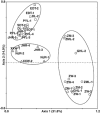The biogeography of fungal communities in wetland sediments along the Changjiang River and other sites in China
- PMID: 23446835
- PMCID: PMC3695295
- DOI: 10.1038/ismej.2013.29
The biogeography of fungal communities in wetland sediments along the Changjiang River and other sites in China
Abstract
Whether fungal community structure depends more on historical factors or on contemporary factors is controversial. This study used culture-dependent and -independent (polymerase chain reaction-denaturing gradient gel electrophoresis (PCR-DGGE)) methods to assess the influence of historical and contemporary factors on the distributions of fungi in the wetland sediments at 10 locations along the Changjiang River and at 10 other locations in China. The culture-dependent approach detected greater species diversity (177 operational taxonomic units (OTUs)) than PCR-DGGE analysis (145 OTUs), and the species in the genera of Penicillium (relative frequency=16.8%), Fusarium (15.4%), Aspergillus (7.6%), Trichoderma (5.8%) and Talaromyces (4.2%) were dominant. On the basis of DGGE data, fungal diversity along the Changjiang River increased from upstream to downstream; altitude explained 44.8% of this variation in diversity. And based on the data from all 20 locations, the fungal communities were geographically clustered into three groups: Southern China, Northern China and the Qinghai-Tibetan Plateau. Multivariate regression tree analysis for data from the 20 locations indicated that the fungal community was influenced primarily by location (which explained 61.8% of the variation at a large scale), followed by total potassium (9.4%) and total nitrogen (3.5%) at a local scale. These results are consistent with the concept that geographic distance is the dominant factor driving variation in fungal diversity at a regional scale (1000-4000 km), whereas environmental factors (total potassium and total nitrogen) explain variation in fungal diversity at a local scale (<1000 km).
Figures





References
-
- Bates ST, Nash TH, Garcia-Pichel F. Patterns of diversity for fungal assemblages of biological soil crusts from the southwestern United States. Mycologia. 2012;104:353–361. - PubMed
-
- Beijerinck M. De Infusies en de Ontdekking der Backterien, Jaarboek van de Koninklijke Akademie v. Wetenschappen, Muller: Amsterdam, Netherlands; 1913.
-
- Brown JKM, Hovmoller MS. Epidemiology—aerial dispersal of pathogens on the global and continental scales and its impact on plant disease. Science. 2002;297:537–541. - PubMed
-
- Buée M, Reich M, Murat C, Morin E, Nilsson RH, Uroz S, et al. 454 Pyrosequencing analyses of forest soils reveal an unexpectedly high fungal diversity. New Phytol. 2009;184:449–456. - PubMed
-
- Bärlocher F, Stewart M, Ryder DS. Analyzing aquatic fungal communities in Australia: impacts of sample incubation and geographic distance of streams. Czech Mycol. 2011;63:113–132.
Publication types
MeSH terms
LinkOut - more resources
Full Text Sources
Other Literature Sources
Medical

